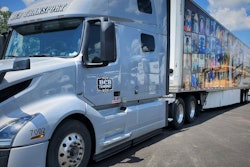When Kim Richardson, president of KRTS Transportation Specialists, and his wife, CFO of the company, would talk shop around the dinner table, his young kids would get involved and ask questions. Now those kids have leadership roles within his company with plans in place for them to one day take over.
“For us, succession planning probably started 30 years ago,” Richardson said.
Ashley Kordish, CEO of Ralph Moyle Inc., worked her way up through her family’s trucking company, taking on roles in every department, learning everything from dispatch to maintenance and repair, and even obtaining her CDL. She said her kids, 4 and 6 years old, will one day take over the business if that’s what they want to do, but they’ll first have to earn their stripes like she did.
Companies across every industry are experiencing a shift in leadership as longtime leaders – part of the aging Baby Boomer population – make their way to retirement. Kordish and Richardson recently took part in a Truckload Carriers Association webinar on succession planning. The webinar included three different companies with three different succession experiences. Richardson is still heading up his company as his children wait in the wings, while Kordish has taken the helm with her father and uncle still advising her. Tim Chrulski, COO of Garner Trucking, is also part of a family-owned company, but he’s not related. He was brought in to help bridge the gaps between leadership.
The three, along with Marilyn Surber, head of industry relations at Tenstreet, offered advice on how to successfully plan succession. While all have a different perspective, the consensus was to start early and communicate the plan as it evolves to everyone – from drivers to managers and beyond – each step of the way.
“When people don't know what's going on, and they just have to make assumptions, that's when people get scared; that’s when things don't go well,” Surber said. “Be clear and set realistic expectations for yourself and your team and your company.”
Take it slow
Every time Kordish moved up within the company, the company sent out an internal communication to everyone in the organization to let them know what was happening.
She said communicating through each step helped the company’s employees accept her as a leader.
“One of the things I was determined to do was gain the respect of the employees that I would eventually be leading. So one of my strategies with that was I wanted to learn as much as possible, so I spent time in every single area for a period of time,” she said. “That has really helped, I think, with gaining that credibility and realizing that I wasn't just there because of my name … Once we hit that succession planning, I think it really made it a little bit easier, and the employees were a little more open to that happening because they watched me go through all that.”
She said she, her uncle and her father began the process of passing the baton about five years ago, and they have yet to retire themselves as they continue to mentor her. It’s important, she said, to be very deliberate with the succession plan and take your time.
Kordish is already looking for the future leaders of her company.
She said she is observing the upcoming generations. When she gives them a task, she gauges how they react. She’s looking at how they work with the team, if they go above and beyond, if they are taking care of their team members and drivers. Then she discusses a career path with them.
“Those are the type of people I want to be able to bring up in my company,” Kordish said.
Surber said companies need to identify potential leaders early on and begin working on their development. Her advice is to create a formalized education program or a mentorship program to give younger generations an opportunity to engage so leadership can discover who is interested in moving up and also evaluate their skills and abilities.
“Let them know you're invested in their future, and give opportunities for leaders to succeed over time,” Surber said. “When you don't have to rush it, it can be a lot easier. So make sure you're giving yourself, the people you're appointing to succeed you, and your entire company the time for these changes to happen in a gradual manner.”
Adapting with the unpredictable
But sometimes a company doesn’t have the time to take it slow.
At Garner, an unexpected and untimely death in the family, the current owner, president and CEO had to learn her new role very quickly. She even brought in someone from the outside to help her with the transition.
Chrulski said sometimes the next generation of leadership isn’t old enough or doesn’t quite yet have the experience level to step into that role. And sometimes there isn’t someone within the organization already who wants to take over, yet employees aren’t comfortable and open to accepting someone from the outside. Chrulski said an option there is to go ESOP. Surber said you can also look at bringing someone in from the outside and placing them in a manager or director role to start so the organization has time to acclimate to them before they take over in an executive capacity.
Kordish’s children may decide they want to take on the family business, but that’s a decision more than a decade-away. Richardson’s children are already solidified in the family business.
His son, who now runs the company’s training school facilities, worked in a different department every summer when he would come home from university, and he eventually earned every certificate the company offers. And his daughter worked within the company to pay for her athletic career before joining the leadership team.
“My kids have earned every stripe … They've earned the respect of not only their peers and associates at our offices and in our businesses, but in the industry,” Richardson said. “Succession planning is every day. It doesn’t start in July and end in December. Succession planning starts every day with cross training at all levels of your company.”
Richardson said whether it’s a family member taking over, a longtime employee or someone on the outside, it is important to find someone who embodies your company’s culture.
Successful succession planning
Chrulski said the most important thing is preserving the company’s original culture while merging in the new culture that comes with new leadership.
Surber offered some additional tips to help with that transition.
• Determine how you will be involved in the transition and what your support role will look like after stepping down, whether that be as a board member or an adviser. Make sure you’re ready to let go and let someone else lead.
• Consider how the succession plan is going to impact you and your family.
• Identify the keys to your success. Pass along your wisdom and tribal knowledge.
“If you're in a position to be training your successor, then you've obviously done something right,” she said. “Make sure you build those qualities and those keys to success into the next generation when you're handing over the reins. Make sure you build a leadership team that you trust and that aligns with your values.”













